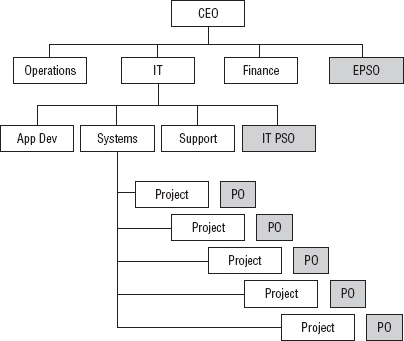Understanding the Organizational Placement of the PSO
There are three organizational placements for the PSO, as shown in Figure 13-1.
At the enterprise level, a PSO is usually called by some name like Enterprise PSO (EPSO) that suggests it serves the entire enterprise. I have seen the following two variations of EPSOs:
- Centralized — In this version, the EPSO provides all of the services to all project teams corporate-wide that any PSO would provide.
- Decentralized — This version (a.k.a. hub-and-spoke) often has a policy and procedure responsibility with satellite PSOs providing the actual functions in accordance with the established policy and procedures.
Figure 13-1: Organizational placement of the PSO

Both models can be effective. The size of the organization with respect to the number of projects needing support is the best determinant of structure, with the decentralized structure favoring the larger organization. There really are no hard-and-fast rules here.
The PSO can also serve the needs of a significant part of the enterprise — such as at the division or business-unit level. The most common example is the IT division. Here the PSO serves the needs of all the IT professionals in the organization (IT PSO in Figure 13-1, for example). Because this PSO is discipline-specific, it will probably offer project support services tailored to the needs of the IT projects. It may also ...
Get Effective Project Management: Traditional, Agile, Extreme, Sixth Edition now with the O’Reilly learning platform.
O’Reilly members experience books, live events, courses curated by job role, and more from O’Reilly and nearly 200 top publishers.

